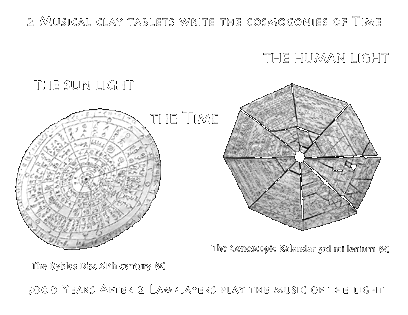
The story of
2 MUSICAL CLAY TABLETS

During the 1921 excavations in the Indus valley (Pakistan), a team of archaeologists led by E. Comte discovered an octagonal clay tablet on the site of Mohenjo-Daro. This scripture remains unique to the present day. The Indusian octagon dates back to the third millennium BC. It is engraved with combined ideograms which might have formed a table of laws. An extensive study has made possible the deciphering of the tablet's function: the signs only describe spatio-temporal movements distinct from those of the rebusian scripture. Its layout seemed to be calculated in order to organize time: a calendar dividing a seasonal year into 8 dodecades of unequal length; a 96 days' cycle in 3 lunar months. Accompanying the evolution of seasons throughout the solar year may well have been its aim. Compared to our present Gregorian calendar, this one would have a 19 day time-lag in each year with a 31 day time-lag in relation to its contemporaneous Chaldean calendar. Deciphering remained open because the signs described different movements (for each part of the 96 periods) not corresponding to any practical organization nor any description of objects. The publication in The International Archaeology Review of this discovery, with photograph of the tablet, attracted the attention of musicologist M. Shadow-Sky, a specialist of protohistoric music. According to his sources, he discovered that the tablet was indeed a playfully used musical calendar. The disc-shaped tablet (the hole in the center was meant for circular reading) can be used to signify the moments' sounding of the 12 lunar months (4 cycles of 96 days). The sounds come from an instrument which may be an articulated lamp with spirals. His deduction of the instrument was based on the small pictograms at the top left of each group of signs. The choice of a lamp as a musical instrument, according to M. Shadow-Sky, can be traced back to two criteria: first, its peculiar and immediately recognizable tone; second, the symbolic relationship of the discovery of a light source which human beings can control. Given the absence of spiritual symbols, the meaning of this music did not relate to any religious ceremony but rather to a decree published by the cities of Indus, Mesopotamia and Egypt, and voted for by the three government majorities. This decree authorized the displacement of temporalities for a crowd of players in a ludic state (the decree is kept in the library of Delhi). The Games were divided into 4 groups and mixed according to chance, competition, enactment and vertigo. The annotated symbols of the Indus tablet refer to the choice of each sound-group according to the period played. The musical calendar revolves around 96 constantly changing sound profiles having a tendency to begin a new at each new cycle. If this calendar may seem in some respects distant from the Chaldean one of the same period, it is only because its functions differ. The Genoscopic Kalandar does shed some light on different time levels in order to submerge the players into the game of sounds: a kind of ludic musical sport linking different civilizations. In 1981, a fire destroyed the Archaeological Institute of Baghdad thus causing the tablet's loss. As of today, only M. Shadow-Sky's 1980 accounts survive. His transcription is sufficiently readable that it can now be used again. Following the musicologist's initiative, the "Lamplayers" perpetuates the Games of the "Ludus Musicae Temporarium," as they were referred to in Latin according to E. Gjerstad's 1959 reconstruction on a Roman archeological site. Given the absence of anniversary celebration and gods' worship, the Ludus Musicae Temporarium is the only non-religious, non-seasonal game across the Roman Empire. G. Säflund views the Temporarium as the ephemeral edifice of the Ludus Musicae. During the 1936 Lebanon excavations on the Byblos site, P. Montet discovered a clay disc with Phoenician pictograms, numbers and alphabet dating back to the XIth century BC. It occurred to M. Shadow-Sky that the principle governing time organization was the same as the Genoscopic Kalandar's. The Byblos Disc, however, is a poetic variant of the Mohenjo-Daro musical calendar and defines the bases of Time Musical Games. Composed over a three-day period, it included nine circles describing the different parts of the day: the images generated by the sun's varying positions as described within the fourth circle in the "Used Life Hours"; the psychic images coming from the generating sun described by the "Memory Reactive Clock" within the sixth and seventh circles and, finally, the ninth circle indicating the metric duration determined by the use of waterclocks.
"2 Lamplayers 5000 Years After" suggest music from the Byblos Disc kept in the Damas library.
John Blacking, (University of Washington). Belfast 1981.